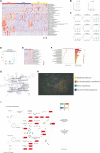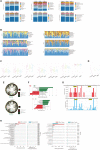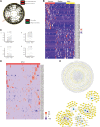Intestinal flora induces depression by mediating the dysregulation of cerebral cortex gene expression and regulating the metabolism of stroke patients
- PMID: 36533076
- PMCID: PMC9748625
- DOI: 10.3389/fmolb.2022.865788
Intestinal flora induces depression by mediating the dysregulation of cerebral cortex gene expression and regulating the metabolism of stroke patients
Abstract
Post-stroke depression (PSD) is a common cerebrovascular complication characterized by complex pathogenesis and poor treatment effects. Here, we tested the influence of differentially expressed genes (DEGs), non-targeted metabolites, and intestinal microbes on the occurrence and development of PSD. We acquired gene expression profiles for stroke patients, depression patients, and healthy controls from the Gene Expression Omnibus database. After screening for DEGs using differential expression analysis, we identified common DEGs in stroke and depression patients that were considered to form the molecular basis of PSD. Functional enrichment analysis of DEGs also revealed that the majority of biological functions were closely related to metabolism, immunity, the nervous system, and microorganisms, and we also collected blood and stool samples from healthy controls, stroke patients, and PSD patients and performed 16S rDNA sequencing and untargeted metabolomics. After evaluating the quality of the sequencing data, we compared the diversity of the metabolites and intestinal flora within and between groups. Metabolic pathway enrichment analysis was used to identify metabolic pathways that were significantly involved in stroke and PSD, and a global metabolic network was constructed to explore the pathogenesis of PSD. Additionally, we constructed a global regulatory network based on 16S rDNA sequencing, non-targeted metabolomics, and transcriptomics to explore the pathogenesis of PSD through correlation analysis. Our results suggest that intestinal flora associates the dysregulation of cerebral cortex gene expression and could potentially promote the occurrence of depression by affecting the metabolism of stroke patients. Our findings may be helpful in identifying new targets for the prevention and treatment of PSD.
Keywords: cerebral cortex; depression; intestinal flora; metabolism; stroke.
Copyright © 2022 Li, Han, Zhao, Huang, Feng, Huang, Lan, Huang, Wang, Shen, He, Li, Song, Wang and Meng.
Conflict of interest statement
The authors declare that the research was conducted in the absence of any commercial or financial relationships that could be construed as a potential conflict of interest.
Figures






Similar articles
-
Machine learning algorithms assisted identification of post-stroke depression associated biological features.Front Neurosci. 2023 Mar 8;17:1146620. doi: 10.3389/fnins.2023.1146620. eCollection 2023. Front Neurosci. 2023. PMID: 36968495 Free PMC article.
-
Peripheral blood and urine metabolites and biological functions in post-stroke depression.Metab Brain Dis. 2022 Jun;37(5):1557-1568. doi: 10.1007/s11011-022-00984-9. Epub 2022 Apr 19. Metab Brain Dis. 2022. PMID: 35438379
-
Alteration of Gut Microbiome and Correlated Lipid Metabolism in Post-Stroke Depression.Front Cell Infect Microbiol. 2021 Apr 22;11:663967. doi: 10.3389/fcimb.2021.663967. eCollection 2021. Front Cell Infect Microbiol. 2021. PMID: 33968807 Free PMC article.
-
The etiology of poststroke-depression: a hypothesis involving HPA axis.Biomed Pharmacother. 2022 Jul;151:113146. doi: 10.1016/j.biopha.2022.113146. Epub 2022 May 26. Biomed Pharmacother. 2022. PMID: 35643064 Review.
-
The advances of post-stroke depression: 2021 update.J Neurol. 2022 Mar;269(3):1236-1249. doi: 10.1007/s00415-021-10597-4. Epub 2021 May 30. J Neurol. 2022. PMID: 34052887 Review.
Cited by
-
The evolving landscape of involvement of DTYMK enzymes in cancer.Med Oncol. 2023 Jun 26;40(8):213. doi: 10.1007/s12032-023-02086-7. Med Oncol. 2023. PMID: 37358701 Review.
-
Gut microbiota of patients with post-stroke depression in Chinese population: a systematic review and meta-analysis.Front Cell Infect Microbiol. 2025 May 1;15:1444793. doi: 10.3389/fcimb.2025.1444793. eCollection 2025. Front Cell Infect Microbiol. 2025. PMID: 40375894 Free PMC article.
-
Comprehensive evaluation of Dragon's Blood in combination with borneol in ameliorating ischemic/reperfusion brain injury using RNA sequencing, metabolomics, and 16S rRNA sequencing.Front Pharmacol. 2024 May 9;15:1372449. doi: 10.3389/fphar.2024.1372449. eCollection 2024. Front Pharmacol. 2024. PMID: 38783945 Free PMC article.
-
Modulating Gut Microbiota: The Mechanism of Electroacupuncture at the "Siguan" Acupoints in Alleviating Post-Stroke Depression.Neuropsychiatr Dis Treat. 2025 Feb 14;21:281-294. doi: 10.2147/NDT.S495460. eCollection 2025. Neuropsychiatr Dis Treat. 2025. PMID: 39967830 Free PMC article.
-
Acupuncture treatment for post-stroke depression: Intestinal microbiota and its role.Front Neurosci. 2023 Mar 21;17:1146946. doi: 10.3389/fnins.2023.1146946. eCollection 2023. Front Neurosci. 2023. PMID: 37025378 Free PMC article. Review.
References
LinkOut - more resources
Full Text Sources

